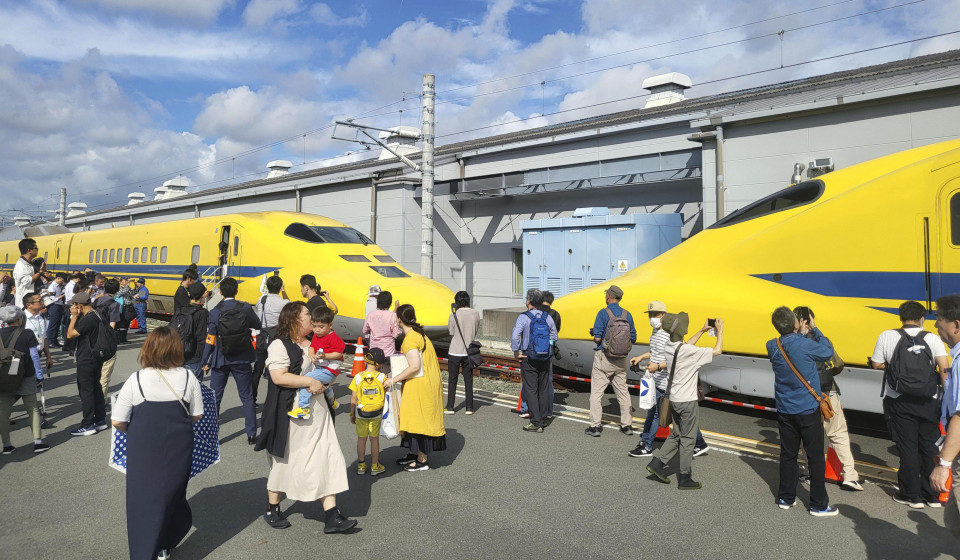From January, Japan is set to retire its famed “Doctor Yellow” bullet trains, which have been instrumental in diagnosing faults along the country’s high-speed Shinkansen lines for approximately 60 years. These special trains, in their distinctive yellow livery, have become a legendary symbol for railway enthusiasts in Japan, shrouded in mystique due to their undisclosed operating schedules. This secrecy has fueled a popular belief that spotting a Doctor Yellow Train is a harbinger of good fortune.
 Two "Doctor Yellow" track-testing bullet trains are displayed at JR Central's Hamamatsu Workshop in Hamamatsu, Shizuoka Prefecture, in October 2024. (Kyodo)
Two "Doctor Yellow" track-testing bullet trains are displayed at JR Central's Hamamatsu Workshop in Hamamatsu, Shizuoka Prefecture, in October 2024. (Kyodo)
The Doctor Yellow fleet currently consists of two trains, the T4 and T5 versions. These trains have diligently operated on the Tokaido and Sanyo Shinkansen lines, stretching from Tokyo to Hakata Station in Fukuoka, carrying no passengers but a wealth of diagnostic equipment. JR Central, the operator of the T4, has announced that this model, which began service in 2001, will cease operations in January. The T5, operated by JR West, is scheduled to retire after 2027. JR Central stated in June that the retirement of the aging T4 will not be accompanied by a direct successor. Instead, the responsibility of track and overhead wire inspection will be taken over by passenger-carrying N700S bullet trains, which will be equipped with advanced testing and observation technology starting in 2027. The T5 model debuted in 2005 and will continue its service for a few more years.
The popularity of the Doctor Yellow train was evident in October when JR Central hosted an event at its Hamamatsu factory. As part of the 60th-anniversary celebrations of Japan’s Shinkansen bullet trains, visitors were given a rare opportunity to tour the inside of a Doctor Yellow train. This event highlighted the train’s special place in the hearts of railway fans and the public alike. The announcement of the retirement also sparked a significant surge in sales of Doctor Yellow merchandise, including toys, with sales increasing ninefold in the week following the news.
The origins of the Doctor Yellow train can be traced back to the early days of the Shinkansen. Shortly after the commencement of Shinkansen services in 1964, with trains reaching speeds of up to 210 kilometers per hour, concerns arose about the need for robust diagnostic measures to monitor the stress on the railway infrastructure. The first Doctor Yellow, the T1, was created by modifying a 0-series Shinkansen train and painting it yellow. The yellow color was chosen partly to enhance visibility during nighttime maintenance work. As daytime operations expanded, and sightings of the train became more frequent, the names “Doctor Yellow” and “train doctor” entered common usage, cementing the train’s unique identity.
The current T4 and T5 Doctor Yellow trains are equipped with sophisticated technology that allows them to perform inspections at speeds up to 270 kph. These trains can detect rail deformities as small as millimeters, ensuring the continued safety and smooth operation of the Shinkansen network. Each Doctor Yellow train undertakes a comprehensive inspection over a two-day round trip between Tokyo and Hakata, a distance exceeding 1,000 km. These vital tests are conducted approximately every ten days, playing a crucial role in maintaining the high standards of Japan’s bullet train system.
Hiroya Mochizuka, an official at JR Central, expressed gratitude for the trains’ extensive service. Reflecting on their upcoming retirement, he humorously suggested that passengers could imagine the spirit of Doctor Yellow living on, with its diagnostic work being carried out by “doctors who ride the trains,” ensuring the legacy of safety and precision continues within the Shinkansen system.
Related coverage:
Japan’s busiest shinkansen linking Tokyo, Osaka marks 60th anniv.
Japan’s popular Nozomi bullet trains eye reducing nonreserved seats
Shizuoka Pref. to grant boring survey for maglev train project
